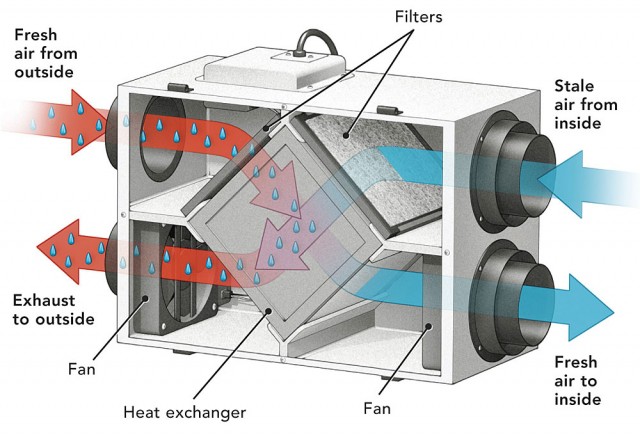Simple Tips to Maximize HRV Performance
Exactly How Heat Recovery Ventilation Boosts Indoor Air Top Quality and Reduces Power Costs
Heat Recovery Ventilation (HRV) systems play a crucial role in improving interior air top quality while at the same time reducing power expenditures. By efficiently trading stale indoor air with fresh exterior air, HRVs aid preserve perfect moisture and minimize pollutants. Furthermore, their capability to recuperate heat from outbound air minimizes the pressure on heating and cooling down systems. As power costs proceed to increase, understanding the complete capacity of HRV systems becomes progressively essential for house owners and services alike.
Recognizing Heat Recovery Ventilation Equipments

Heat recovery ventilation (HRV) systems play an essential role in enhancing interior air quality, specifically in modern-day, energy-efficient buildings. These systems are made to move warm from the outward bound stale air to the incoming fresh air, consequently minimizing energy loss while maintaining excellent temperature levels inside your home. HRVs are composed of a heat exchanger, followers, and ductwork, helping with the continuous circulation of air. By getting rid of indoor pollutants and introducing fresh air, HRVs help to balance humidity levels, avoid mold growth, and decrease allergens. The efficiency of HRV systems exists in their capacity to recover approximately 80% of the warmth from the worn down air, promoting power conservation while making sure a healthy interior atmosphere. Their assimilation is important in accomplishing lasting living techniques.
The Value of Indoor Air Top Quality
Indoor air quality (IAQ) is a critical variable affecting the health and wellness and wellness of residents in any setting. Poor IAQ can cause different health issues, consisting of respiratory issues, allergic reactions, and tiredness. Furthermore, it can exacerbate status quo such as asthma. Factors adding to low IAQ include pollutants from interior resources like cleaning up representatives, mold, and poor ventilation. Consequently, preserving good IAQ is essential for promoting a secure and comfy living or working room. Efficient techniques to boost IAQ involve normal tracking of air top quality, appropriate air flow systems, and lessening making use of harmful compounds inside. By prioritizing IAQ, people can guarantee a healthier setting that fosters efficiency and overall lifestyle.
Energy Efficiency Perks of HRV Solutions
Several homeowners and building managers are increasingly acknowledging the energy effectiveness benefits of warm recuperation air flow (HRV) systems. By moving warmth from worn down interior air to inbound fresh air, HRV systems considerably decrease the energy required for cooling and heating. This process minimizes reliance on traditional heating and cooling systems, resulting in lower energy bills. Additionally, HRVs aid keep a well balanced interior climate, avoiding excessive heating or cooling needs. The capacity to recover as much as 90% of the warm from outbound air additionally sustains sustainability initiatives by reducing general energy usage. HRV systems add not just to set you back financial savings yet additionally to a lowered carbon footprint, lining up with the growing emphasis on energy-efficient structure practices.
Setup and Upkeep Considerations
The effective execution of warmth recuperation air flow (HRV) systems calls for careful consideration of setup and upkeep aspects to ensure peak efficiency. Proper positioning of the HRV unit is essential, as it needs to be mounted in a location that optimizes airflow while lessening noise disturbance. Additionally, ductwork has to be appropriately sized and shielded to avoid power loss. Routine maintenance, consisting of filter replacement and system cleaning, is critical to protect optimum functionality and interior air high quality. Proprietors need to develop a normal maintenance routine to recognize and resolve possible concerns before they rise. Cooperation with skilled professionals throughout both installation and maintenance read the full info here stages can enhance the longevity and effectiveness of HRV systems, inevitably leading to much better interior atmospheres and decreased power expenses.
Real-World Applications and Success Stories
Discovering real-world applications of heat recuperation air flow (HRV) systems exposes their considerable influence on indoor air high quality and power effectiveness across various settings. In household buildings, property owners have actually reported enhanced air quality, causing less allergic reactions and respiratory system issues. Schools applying HRV systems have actually kept in mind improved trainee concentration and decreased absenteeism because of much better ventilation. Business structures, such as offices and retail areas, have experienced reduced energy prices and raised staff member performance. A business workplace in a warm climate accomplished a 30% decrease in energy bills after mounting an HRV system. These success tales demonstrate that HRV technology not only adds to much healthier atmospheres however also gives substantial monetary benefits, making it a valuable financial investment for different sectors.
Often Asked Questions
Can HRV Solutions Decrease Irritants in Indoor Air?
The performance of HRV systems in minimizing indoor allergens primarily hinges on their capability to filter and browse around this site exchange air. HRV Heat Recovery Ventilation. By constantly changing stale air, these systems can substantially reduce irritant levels throughout indoor environments

Just How Does Humidity Affect HRV System Performance?
Humidity greatly affects HRV system performance; high levels can bring about condensation, minimizing efficiency, while reduced moisture may enhance air exchange. Stabilizing moisture is important for ideal procedure and keeping interior air top quality.
Are HRV Systems Noisy Throughout Operation?
HRV systems can produce differing sound levels during procedure, depending on their style and installation. Some devices run silently, while others may create recognizable audio, specifically at higher airflow settings or when badly preserved.
What Is the Average Life-span of an HRV System?

Can HRV Systems Be Utilized in All Climates?
HRV systems can be used in various environments, but their efficiency may vary - HRV Heat Recovery Ventilation. In severe temperatures, changes or supplemental systems may be needed to ensure excellent efficiency and comfort while keeping indoor air quality